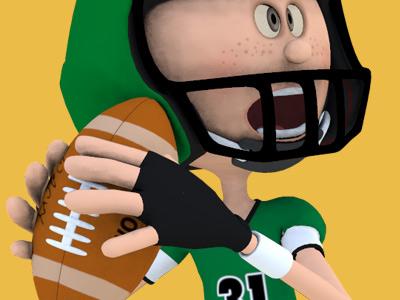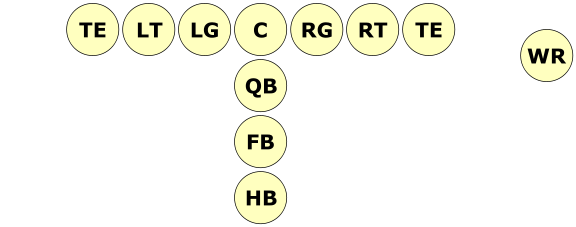American football

I formation (American Football Strategy)
The I formation is one of the most common offensive formations in American football. The I formation draws its name from the vertical (as viewed from the opposing endzone) alignment of quarterback, fullback, and running back, particularly when contrasted with the same players' alignments in the T formation.
The formation begins with the usual 5 offensive linemen (2 offensive tackles, 2 guards, and a center), the quarterback under center, and two backs in-line behind the quarterback. The base variant adds a tight end to one side of the line and two wide receivers, one at each end of the line.

Standard I formation
Typical roles
The I formation is typically employed in running situations. In the I formation, the tailback starts six to eight yards behind the scrimmage from an upright position, where he can survey the defense. The formation gives the tailback more opportunities for finding weak points in the defense to run into.
The fullback typically fills a blocking, rather than rushing or receiving, role in the modern game. With the fullback in the backfield as a blocker, runs can be made to either side of the line with his additional blocking support. This is contrasted with the use of tight ends as blockers who, being set up at the end of the line, are able to support runs to one side of the line only. The fullback can also be used as a feint—since the defense can spot him more easily than the running back, they may be drawn in his direction while the running back takes the ball the opposite way.
Despite the emphasis on the running game, the I formation remains an effective base for a passing attack. The formation supports up to three wide receivers and many running backs serve as an additional receiving threat. While the fullback is rarely a pass receiver, he serves as a capable additional pass blocker protecting the quarterback before the pass. The running threat posed by the formation also lends itself to the play-action pass. The flexible nature of the formation also helps prevent defenses from focusing their attention on either the run or pass.
Common variations
Many subtypes of the I formation exist, generally emphasizing the running or passing strengths of the base version.
- The Big I places a tight end on each side of the offensive line (removing a wide receiver). Coupled with the fullback's blocking, this allows two additional blockers for a run in either direction. This is a running-emphasis variant.
- The Power I replaces one wide receiver with a third back (fullback or running back) in the backfield, set up to one side of the fullback. This is a running-emphasis variant.
- The Jumbo or Goal-line formation further extends the Power I or Big I, adding a second tight end and/or third tackle to the line, respectively. This variant has no wide receivers and is all but exclusively a running formation intended to reliably gain minimal yardage, most commonly two yards or less.
- The Three-wide I replaces the tight end with a third wide receiver. This is a passing-emphasis variant.
- The Maryland I (also known as the Stack I or Golden I) is similar to the Power I except that instead of placing the third back to one side of the fullback, the fullback, third back, and tailback line up directly in front of each other (hence the term “Stack”). Obviously, this is a running-emphasis variant made popular by the Maryland Terrapins football team of the 1950s under Tom Nugent.
- The Tight I is similar to the Maryland I except that the extra back (who happens to be the tight end) is aligned between the quarterback and fullback in the alignment. The split end and the player who normally lines up as flanker are both aligned on the line of scrimmage split away from the end man on the line of scrimmage. This formation was used by the Kansas City Chiefs in Super Bowl IV against the Minnesota Vikings so as to create confusion in the Minnesota defense's lining up against the Chiefs offense.

Big I formation variation
The I formation, in any variant, can also be modified as Strong or Weak. This formation is commonly called an Offset I. In either case, the fullback lines up roughly a yard laterally to his usual position. Strong refers to a move towards the TE side of the formation (Primary TE, or flanker's side when in a "big" 2TE set), weak in the opposite direction. These modifications have little effect on expected play call. However, the Offset I allows a fullback to more easily avoid blockers and get out of the backfield to become a receiver.
SPORTS



American Football
Game play in American football consists of a series of downs, individual plays of short duration, outside of which the ball is dead or not in play. These can be plays from scrimmage – passes, runs, punts, or field goal attempts (from either a place kick or a drop kick) – or free kicks such as kickoffs and fair catch kicks. Substitutions can be made between downs, which allows for a great deal of specialization as coaches choose the players best suited for each particular situation. During a play, each team should have no more than 11 players on the field, and each of them has specific tasks assigned for that specific play.
Rules and gameplay
- Scoring
- Maneuvers
- Strategy
- Play types
- Penalties
- Turnovers
- Downs
- Teams and positions
- Field
- Equipment
- Duration and time stoppages
- Advancing the ball and downs
- Kicking
- Officials and fouls
Positions
Offensive (Interior) line
Backs and receivers
Defensive line
Linebackers
Defensive backs
Special teams
- Kicker (K)
- Holder (H)
- Long snapper (LS)
- Punter (P)
- Kickoff specialist (KOS)
- Kick returner (KR) and Punt returner (PR)
- Upback
- Gunner
- Jammer


RESOURCES
This article uses material from the Wikipedia articles "American football", "American football rules", "Strategy", "I formation", which is released under the Creative Commons Attribution-Share-Alike License 3.0.
© Stories Preschool. All Rights Reserved.





